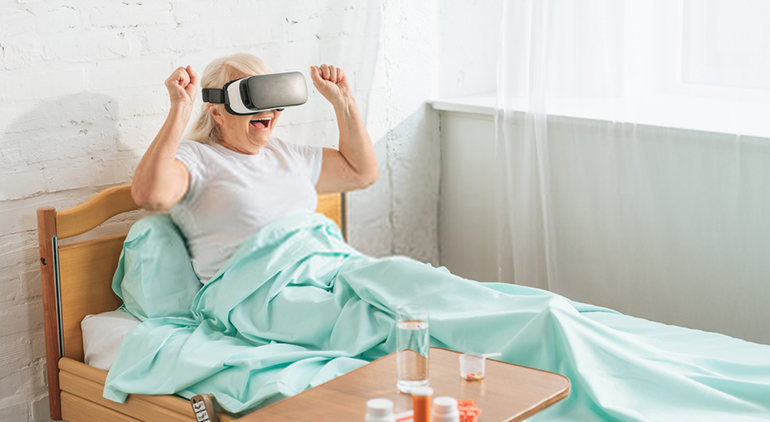Depression is a serious mental health condition that can cause immense suffering to those who experience it. But what if there was a way to alleviate the symptoms of depression using technology? Enter augmented depression therapy, a promising new form of treatment that combines traditional therapy with cutting-edge tech tools. In this blog post, we’ll explore all aspects of augmented depression therapy – from its origins and benefits to how it works and who can benefit from it.
Contents
What is Augmented Depression Therapy?

Augmented depression therapy is a type of treatment that combines traditional talk therapy with brain stimulation techniques. This approach is designed to help people who have not responded well to other forms of treatment for depression.
Two main types of brain stimulation techniques are used in augmented depression therapy: transcranial magnetic stimulation (TMS) and transcranial direct current stimulation (tDCS). These techniques work by applying electrical currents to specific areas of the brain. This can help to improve mood and reduce symptoms of depression.
Augmented depression therapy is still considered to be experimental, but it is showing promise as a treatment option for people who have not responded well to other forms of treatment. If you are considering this type of treatment, be sure to discuss it with your doctor or mental health professional to see if it is right for you.
How Does It Work?
This is a form of treatment that combines traditional cognitive behavioral therapy (CBT) with transcranial magnetic stimulation (TMS). TMS is a non-invasive brain stimulation technique that uses magnetic fields to stimulate nerve cells in the brain. This combination of therapies has shown to be effective in treating patients with depression who have not responded well to other forms of treatment, such as medication or CBT alone.
During ADT, patients receive a daily TMS session for four to six weeks while also attending weekly CBT sessions. Furthermore, The TMS sessions are usually administered in the morning, and the CBT sessions are typically held in the afternoon or evening.
ADT is an effective treatment for depression, with studies showing that it can reduce symptoms of depression and improve the quality of life for patients with this condition. Furthermore, The working of this type of treatment is based on the idea that TMS can stimulate certain areas of the brain, which in turn can improve mood and reduce symptoms of depression. Additionally, CBT works to address any underlying negative thought patterns or behaviors that may be contributing to a person’s depression.
Who Can Benefit From This Therapy?

If you’re struggling with depression, you may be wondering if there’s anything that can help. You’ve probably heard of therapy and medication, but what about augmented depression therapy?
People with certain disorders, such as :
- Severe Depression: People with severe depression can benefit from augmented depression therapy. This type of therapy combines cognitive behavioral therapy (CBT) with medication to help manage symptoms more effectively than either treatment alone.
- Bipolar Disorder: Augmented depression therapy is commonly used for people suffering from bipolar disorder, as the combination of CBT and medications have been proven to be effective in controlling manic and depressive episodes.
- Post-Traumatic Stress Disorder (PTSD): Augmented depression therapy is also useful for treating PTSD, as it can help people come to terms with traumatic experiences and manage challenging emotions more effectively.
- Social Anxiety: People with social anxiety disorder can also benefit from augmented depression therapy. CBT helps people learn how to recognize and control their fear response, while medications can help minimize the physical symptoms of anxiety.
If you’re considering augmented depression therapy for yourself or a loved one, be sure to speak with your doctor about what type of treatment will be best for your specific situation.
Techniques Used In Augmented Depression Therapy
There are many techniques used in augmented depression therapy, a combination of traditional therapy and medication. These include cognitive-behavioral therapy (CBT), interpersonal therapy (IPT), and problem-solving therapies.
Cognitive-Behavioral Therapy (CBT)
CBT is a type of talk therapy that focuses on challenging negative thought patterns and making changes to how we think about ourselves, our environment, and the world around us. Furthermore, It helps us to identify irrational beliefs and behaviors that contribute to our depression and learn how to modify them with more helpful, balanced thinking.
Interpersonal Therapy (IPT)
IPT is a type of therapy designed to improve our relationships with other people by addressing issues such as communication problems or interpersonal conflicts that may be contributing to our depression. This may be done through role-playing, feedback, or other techniques.
Problem-Solving Therapy
Problem-solving therapy is a form of cognitive-behavioral therapy that focuses on helping us develop and practice skills to identify, analyze, and solve problems in our lives that may be contributing to our depression. This can include learning how to set goals, evaluate options, make decisions, break down tasks into manageable steps, and look at problems from different perspectives.
Pros and Cons of Augmented Depression Therapy

Everything has its own set of pros and cons and augmented depression therapy is no exception. Furthermore, It has some unique advantages, as well as potential drawbacks that should be considered before opting for this type of therapy.
Pros
- Augmented depression therapy utilizes new technologies to help people suffering from depression understand their symptoms better and find solutions more quickly. By using virtual or augmented reality, people can visualize their symptoms and interact with them in a safe environment.
- It is more convenient compared to traditional forms of therapy since it requires less travel time and fewer physical visits to the therapist’s office.
- Augmented depression therapy offers flexibility by allowing patients to access treatment anytime and anywhere, as long as they have the necessary equipment.
- It is non-invasive, making it an ideal choice for those who are uncomfortable with talking to a therapist face-to-face.
Cons
- This depression therapy is relatively new and not yet available in all areas, so access can be limited depending on where one life.
- It can be expensive, as the technology and equipment used need to be purchased or leased.
- Virtual reality technology is not suitable for everyone, especially those with motion sickness or other sensory issues.
- This depression therapy does not replace traditional talk therapy, so it may not provide enough support for some people suffering from severe depression.
Conclusion
Augmented depression therapy is a relatively new type of treatment that has shown promising results in helping people manage their depression. This approach combines talk therapy and pharmacotherapy, giving individuals more individualized care for their unique needs. With the help of an experienced mental health professional, augmented depression therapy can be highly effective for many patients who experience symptoms of clinical depression.
For more information, please contact MantraCare. Depression is a mental illness characterized by persistent feelings of sadness, hopelessness, and loss of interest in daily activities. If you have any queries regarding Online Depression Counseling experienced therapists at MantraCare can help: Book a trial Depression Therapy session


